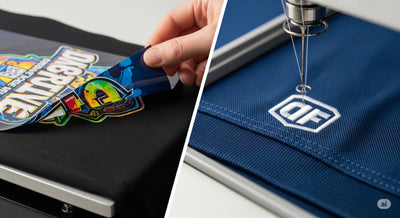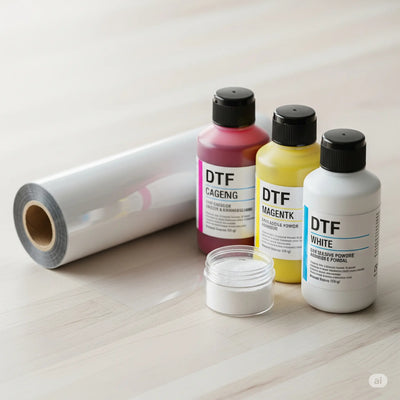

Combining DTF Prints & Embroidery
Aug 19, 2025 (Updated on Sep 26, 2025)
In the ever-evolving world of custom apparel, standing out is the name of the game. T-shirt designers, brand owners, and creative entrepreneurs are constantly on the lookout for the next big thing that will elevate their creations from simple garments to wearable art. Enter the exciting world of mixed media decoration, where two powerhouse techniques—Direct-to-Film (DTF) printing and classic embroidery—come together to create stunning, high-value apparel.
If you're looking to push the boundaries of design and offer your customers something truly unique, this is a technique you need to explore. This guide will walk you through the ins and outs of combining these methods, ensuring your next project is a masterpiece and for those in Texas and beyond looking for impeccable DTF transfers, you'll find that a reliable partner like DTF Dallas can make all the difference.
Why Bother with Both? The Magic of Mixed Media
You might be wondering, "Why go through the trouble of using two different decoration methods on one garment?" The answer is simple: impact. Combining DTF and embroidery allows you to leverage the strengths of both techniques, resulting in a finished product that is greater than the sum of its parts. It's about creating a sensory experience. The smooth, vibrant finish of a DTF print paired with the textured, lustrous sheen of embroidery thread creates a dynamic contrast that catches the eye and invites touch. This multi-layered approach adds a level of sophistication and perceived value that is difficult to achieve with a single method.
Think of it as the difference between a simple sketch and a detailed oil painting. Both have their merits, but the painting offers a depth and richness that a simple line drawing cannot. Similarly, a standard printed tee is functional, but one that incorporates the tactile elegance of embroidery feels more like a premium, thoughtfully designed piece. This is how you turn a $20 t-shirt into a $50 statement piece.
What Each Technique Brings to the Table
To truly appreciate the power of this combination, it's important to understand the unique advantages of each method. They aren't competing; they're collaborating. You could think of it like a musical duet; one technique provides the foundational melody while the other adds the intricate, textured harmony. By understanding the specific strengths each method possesses, you can assign them roles within your design that play to those strengths. This strategic approach is what separates an amateurish mashup from a professional, high-end mixed-media garment.
We'll start by exploring the capabilities of the newer innovation in this partnership. DTF has fundamentally changed what is possible in terms of color and complexity, offering a level of detail that was previously difficult or incredibly expensive to achieve on such a wide range of fabrics. Understanding its capabilities first helps to frame why the timeless, tactile nature of embroidery makes for such a perfect counterpart. It’s this modern precision that lays the perfect canvas for classic texture.
The Unmatched Vibrancy and Detail of DTF Prints
Direct-to-Film has been a game-changer in the garment decoration industry, and for good reason. DTF printing excels where other methods fall short. It empowers designers to use an unlimited color palette, reproducing everything from photorealistic images to complex gradients without the need for multi-screen setups. The process excels at capturing razor-sharp edges and fine details, ensuring that even the most intricate parts of a design are rendered cleanly because the entire design is printed on the film before being transferred. Colors appear exceptionally bright and opaque, even when applied to dark or challenging fabrics.
- Photorealistic Detail: DTF can reproduce images with stunning clarity, including intricate details, gradients, and a virtually unlimited color palette. This is something that is simply not possible with traditional embroidery.
- Versatility on Fabrics: DTF prints can be applied to a wide array of materials, from cotton and polyester to blends and even hard surfaces. This flexibility opens up a world of creative possibilities.
- Soft Hand Feel: Modern DTF prints are known for their soft, flexible feel that integrates well into the fabric, avoiding the stiff, plastic-like feeling of older transfer methods.
- Cost-Effective for Complex Designs: For designs with many colors or intricate details, DTF is often more cost-effective than setting up multiple thread colors for embroidery.
The Timeless Texture and Premium Feel of Embroidery
Embroidery has been a mark of quality and distinction for centuries. Unlike a flat print, the stitched threads catch the light, creating subtle highlights and shadows that give the design a dynamic, dimensional quality. This tactile nature communicates a sense of durability and permanence, assuring the owner that the design is an integral part of the garment itself. Ultimately, it conveys that extra care and investment were put into the product, which instantly elevates its status from a simple shirt to a premium piece of apparel. It's a classic for a reason.
- Durability and Longevity: A well-digitized and stitched embroidery design is incredibly durable and can often outlast the garment itself. It won't crack, peel, or fade over time.
- High Perceived Value: The raised texture and lustrous sheen of embroidery thread immediately signal quality and craftsmanship. It’s a technique associated with high-end brands, corporate apparel, and premium goods.
- Textural Dimension: Embroidery adds a tactile element to a garment that print alone cannot achieve. It stands out, giving the design depth and a 3D effect.
- Simple, Bold Statements: For logos, text, and minimalist designs, embroidery provides a clean, professional look that is hard to beat.
Designing for Harmony: Key Considerations for Mixed Media Apparel
Creating a successful mixed-media piece isn't as simple as slapping a print and some stitching on a shirt. It requires a thoughtful approach to design. You have to think like both a graphic designer and a textile artist, envisioning how the flat print and the raised threads will coexist on the fabric. The ultimate goal is to create a single, harmonious piece where the two textures don't compete but instead complement each other to elevate the overall impact. This involves carefully considering how the balance, color, and composition of the elements will guide the eye and create a premium feel.
Balancing Act: Complexity and Simplicity
The key to a great mixed-media design is balance. You want the two techniques to complement each other, not compete for attention. A common and effective strategy is to use DTF for the more complex, colorful, or detailed parts of the design, and reserve embroidery for key elements you want to highlight.
For instance, imagine a design featuring a tiger. The intricate stripes, the subtle color gradients of the fur, and the piercing eyes would be perfect for a DTF print. Then, you could use embroidery to stitch the brand name or a powerful word like "FIERCE" over the top or underneath. This gives you the best of both worlds: the photorealism of the tiger and the bold, tactile statement of the text.
Color Theory in Action: Matching and Contrast
Color plays a crucial role in making your design cohesive. The path you choose will dramatically affect the final mood of the piece and should align with your brand's overall aesthetic. Ask yourself: is the goal for the print and stitching to blend seamlessly, or for one element to intentionally stand out and grab attention? Your answer will determine how you select your thread colors concerning the hues present in your DTF design. You have two main options:
- Harmonious Palette: Choose embroidery thread colors that are present in your DTF print. This creates a unified, seamless look where the embroidery feels like a natural extension of the printed design. This approach lends a subtle sophistication to the garment, making the entire design feel like a single, cohesive piece of art. For best results, use a physical thread chart or digital color matching to perfectly align a thread color with a specific Pantone or CMYK value from your print file.
- Bold Contrast: Alternatively, use embroidery to introduce a contrasting color that makes a specific element pop. A metallic gold or silver thread over a full-color DTF print can create a stunning, luxurious effect. This technique is excellent for creating a clear focal point, deliberately guiding the viewer's eye to the most important element, such as a brand name or a key message. Consider using a bright neon thread against a grayscale photo print or a complementary color (like orange thread on a blue design) to create a powerful visual vibration.
When working with your supplier, make sure they can provide accurate thread color matching to your DTF print's Pantone or CMYK values.
Location, Location, Location: Placement and Composition
Where you place each element is critical. Imagine how the elements will interact. You can layer embroidery directly on top of a DTF print, place them side-by-side, or have them interact creatively. When layering, a popular technique is to use the DTF print as the colorful "fill" of a design, while using embroidery to create a sharp, textured outline or highlight key text. The visual "weight" and balance of the composition are key; a large, detailed print on the back of a hoodie can be perfectly complemented by a clean, simple embroidered emblem on the sleeve or chest.
- Layering: This is a popular technique. A DTF print can serve as the background or "fill" of a larger design, with embroidery providing the outlines, details, or text.
- Adjacent Placement: You could have an embroidered logo on the chest and a large DTF print on the back. This is a classic approach that works well for many brands.
- Interactive Design: Get creative! Maybe an embroidered character is holding a DTF-printed object. The possibilities are limited only by your imagination.
From Concept to Creation: The Mixed Media Process
It's a delicate dance between digital precision and hands-on craftsmanship. Each stage, from preparing the artwork to the final heat press, requires careful attention to detail to ensure the two mediums align perfectly. This multi-step journey is what transforms a creative concept into a premium, textured final product ready for market. While the exact steps can vary, here's a general overview of how a mixed-media garment is created:
- The Design Phase: It all starts with a digital design file that separates the elements destined for printing from those to be embroidered. This initial blueprint is the most critical step, as it dictates how both the printing and embroidery machines will read and apply the design. Designers must think in layers at this stage, planning exactly where the smooth, vibrant DTF will sit about the textured, dimensional embroidery.
- DTF Printing: The DTF portion of the design is printed onto a special film. A fine layer of hot-melt adhesive powder is then evenly applied to the wet ink. The film is cured with heat, which melts the powder and bonds it to the ink, creating a durable, storable transfer that is ready for the final application.
- Embroidery Application: The garment is hooped and placed in an embroidery machine. The digitized embroidery design is then stitched onto the fabric. A stabilizer material is placed behind the design area to prevent the fabric from puckering and to create a solid foundation for the stitches. This process is what adds that unmistakable dimension and premium texture, creating the raised element of your mixed-media piece.
- DTF Application: The embroidered garment is then carefully placed on a heat press. The DTF transfer is positioned precisely to the embroidery, and heat and pressure are applied to transfer the print to the garment.
- Quality Control: The finished piece is inspected to ensure both the embroidery and the DTF print are flawless and perfectly aligned. The finished piece is inspected to ensure both the embroidery and the DTF print are flawless and perfectly aligned. Any stray threads from the embroidery are carefully trimmed, and the print is checked for perfect adhesion and color accuracy. This crucial final step guarantees that the garment meets the highest quality standards and is ready to impress the customer.
Given the precision required, especially in the alignment stage, working with an experienced and well-equipped partner is crucial.
Finding the Right Partner for Your Premium Apparel Project
The success of your mixed-media apparel hinges on the quality of both the embroidery and the dtf transfers. You need a partner who has mastered both arts. A company that understands the nuances of fabric types, heat press settings, and embroidery digitization will be your greatest asset. For businesses in the Dallas-Fort Worth area and beyond, seeking out a specialist like DTF Dallas ensures you get high-quality, consistent results. A good partner will not only produce your designs but will also be able to offer advice on your artwork to ensure it translates perfectly to a mixed-media format. They can help you source the right garments and will stand behind the quality of their work.
Elevate Your Brand with Mixed Media
Combining DTF prints and embroidery is more than just a decoration technique; it's a statement. It tells your customers that you care about quality, creativity, and craftsmanship. It allows you to create apparel that is rich in detail, texture, and visual appeal. While it may require a bit more thought in the design phase, the payoff in terms of creating truly premium, high-value products is immense. So, the next time you're brainstorming a new collection, don't just think in one dimension, like mixed media.
Comments 0
Be the first to leave a comment.




